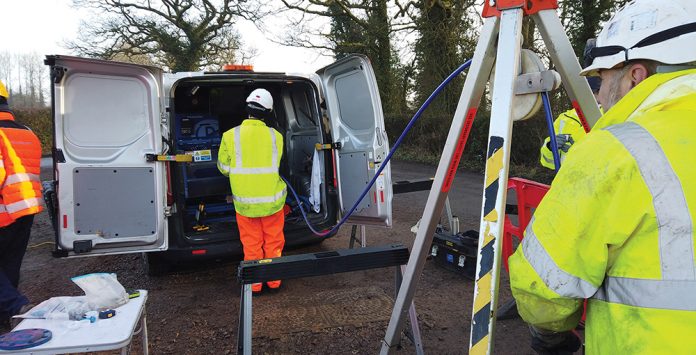Leakage is one of the major challenges facing water companies today – a challenge that is about to get even tougher as we head into the next AMP.
Ofwat has set all of us the task of reducing leakage by 15% over the next five years and at Severn Trent, we’re not wasting any time working out how we’re going to achieve that ambitious target.
We see innovation as one of the driving forces that will help us on that journey, starting with a pioneering fibre optics trial on a live section of our network. We’re using this technology to trial how effective it is at identifying leaks, especially in cast iron pipes, so we can carry out the repair before it escalates into a burst. We believe this proactive approach can be critical in minimising any negative impact on a customer’s water supply.
Working in partnership with Craley Group and API, this ‘lift and shift’ fibre optic cable is a brand new, innovative system that acts as a continuous line of acoustic sensors, listening out for leaks inside the pipe, that can be fitted without the need to disrupt supply.
The first phase of the trial got underway in February, when we installed a 750-metre-long fibre optic cable along a live section of our network, recording noises in real time over a four-hour period. The trial involved simulating several leaks which were all pinpointed by the system. Fitting the cable inside the pipe under pressure, is carried out in a similar way to a CCTV or hydrophone cable – using a winching system, a specially designed pressure chamber and an integrated disinfection system. A drogue, or parachute, is attached to the end of the cable, using the flow of water to feed it through the pipe.
A clever part of this technology is its ability to filter out background noise, using specially adapted software, allowing our engineers to pinpoint any leaks with tremendous accuracy. It’s also able to store the data, which can be reviewed and analysed at a later stage, so comparisons can be made against other surveys of the same stretch of network, to check for any changes or deterioration in the pipe. The trial, which is a first for the UK, isn’t limited to leaks and bursts either. This fibre optic technology can also tell us when and where people are accessing our network illegally.
The next phase of the trial will involve the use of a longer lift and shift cable, fitted with an integrated CCTV camera. Combining a camera with acoustic sensors will take away the need to carry out a separate CCTV investigation, helping to reduce time on-site and reducing the risk of deploying the cable ‘blind’.
If the next phase of the trial is successful, it could potentially replace some of the existing technologies that we currently use to help us identify where issues are on our network. The options available to us now range from listening sticks, acoustic ground microphones, hydrophone sensors and drone or satellite imagery. These approaches are effective, but each have their limitations. Hydrophone sensors for example, only have one sensor at the tip of the cable, in contrast to a continuous line of them.
The trial forms part of Severn Trent’s contribution to the World Water Innovation Fund – a global initiative launched last year, designed to encourage water companies to work together by sharing new technologies and best practice. The fund recently welcomed two new members in February, as PUB – Singapore’s national water agency and Aqualia from Spain joined like-minded water companies who are dedicated to change and protecting the future of water for everyone.



